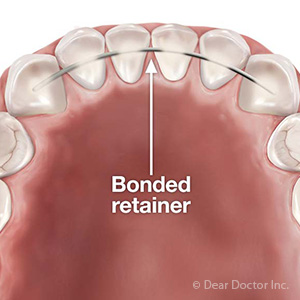Removable or Bonded, Retainers Help Protect Your New Straighter Smile
The straightening process for a crooked smile doesn’t end when the braces come off. There’s one more crucial phase to undergo to make sure we don’t lose the progress you’ve achieved: wearing an orthodontic retainer.
Although often viewed as a nuisance, retainers are important because they prevent realigned teeth from reverting to their old positions. This is possible because the periodontal ligament, the gum attachment that allows us to move teeth in the first place, can contain “muscle memory” that naturally tries to draw teeth back to where they once were.
A retainer prevents this from happening: During wear the subtle pressure they exert keeps or “retains” the teeth in their new positions until they’re firmly established, usually after several months. While most patients initially wear a retainer around the clock, this will gradually taper off until they’re worn primarily during sleep hours.
While retainers come in many different styles and sizes, most fall into one of two categories: removable or non-removable (bonded). The first type, a custom-made appliance a patient can easily take in and out of the mouth, has its advantages. Removing it makes it easier to clean the teeth. They’re also adaptable to reduced wear schedules for eating, brushing and flossing, or for special occasions.
But a removable retainer may be noticeable to others. Its removability can also lead to problems. Out of the mouth they’re prone to be lost, resulting in additional replacement costs. And immature patients may be easily tempted to take them out too often—or not wear them at all.
A bonded retainer solves many of these potential problems. Because the retainer wire is securely bonded to the back of the teeth, it’s not visible to others. And because it can’t be removed except by an orthodontist, there’s virtually no chance of losing it or haphazard wear.
On the other hand, bonded retainers can occasionally break, requiring repair or replacement. And flossing is more difficult than with a removable retainer, although a little training from a dental hygienist can make that easier.
The choice of retainer depends on the individual and their priorities. But whether removable or bonded, a retainer is absolutely essential for protecting your new, hard-earned smile.
If you would like more information on bonded retainers, please contact us or schedule an appointment for a consultation. You can also learn more about this topic by reading the Dear Doctor magazine article “Bonded Retainers.”








